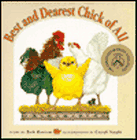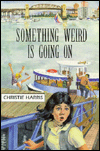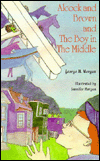Being Big

by Sharen Liddell, Yvonne Cathcart,
ISBN: 0590243780
The Ballad of the Blue Bonnet

by Robert Priest, Debi Perna,
ISBN: 0888991983
Best & Dearest Chick of All

by Bob Barton, Coral Nault,
24 pages,
ISBN: 0889951179
The Night Rebecca Stayed Too Late

by Peter Eyvindson, Rhian Brynjolson,
ISBN: 0921827393
Lizzie's Soccer Showdown

by John Danakas,
ISBN: 1550284649
Something Weird Is Going On

by Christie Harris,
144 pages,
ISBN: 1551430223
Keepers of Life:
Discovering Plants Through Native American Stories & Earth Activities for Children

by Michael Caduto, Joseph Bruchac, John K. Fadden, David K. Fadden, Marjorie Leggitt, Carol Wood,
288 pages,
ISBN: 1555913873
Alcock & Brown & the Boy in the Middle

by George M. Morgan, Jennifer Morgan,
64 pages,
ISBN: 1895387205
Tchaikovsky Discovers America

by Esther Kalman, Rick Jacobson, Laura Fernandez,
40 pages,
ISBN: 1895555825
Post Your Opinion | | Children's Book - Taking Care of Things
by Donna NurseIN HER AUTOBIOGRAPHY ONE WRITER'S Beginnings Eudora Welty describes her young passion for books:
I cannot remember a time when I was not in love with them -- with the books themselves, cover and binding and the paper they were printed on, with their smell and their weight and their possession in my arms, captured and carried off to myself. Still illiterate, I was ready for them, committed to all the reading I could give them.
The Ballad of the Blue Bonnet (Groundwood 24 pages, $12.95 cloth), by Robert Priest, invites such instinctual attachment. It's a simple story about a blue baby bonnet that gets handed down from infant to infant. The ballad unfolds lyrically, each verse adding a new child and toy. Debbie Perna's delicate watercolours of babies, bonnets, and toys revolving in a whimsical "baby-go-round" symbolize the cyclical motion of life. The musical tape that accompanies the book seems somewhat cool and jazzy for babies; but Priest's prose mesmerizes through alliteration and rhyme, making The Ballad of the Blue Bonnet a treasure to be passed down or a keepsake to refresh memories forever.
Best and Dearest Chick of All (Red Deer College, 24 pages, $8.95 paper) also engages the preliterate child through rhyme and repetition. Bob Barton retells the fable of this barnyard Cinderella from Irina Zheleznova's Tales of the Amber Sea. Cheep-Cheep is an adorable chick born of a golden egg. But after his mother disappears and his father takes a new wife his life becomes wretched. CheepCheep's stepmother mistreats him and lavishes all her attention on his new half- brother. Barton's fairy tale contains some antiquated conventions, such as the wicked stepmother, but it also allegorizes two enduring themes that reverberate in the smallest of children, the evils of parental favouritism and the dangers of vanity. The illustrations, by Carol Nault, greatly enhance the story's folk appeal. Nault renders Cheep-Cheep's world in deep greens and muted yellows that summon the sights and smells of harvest, and her occasional use of periwinkle and violet flowers adds a dramatic touch.
Simple, direct language makes The Night Rebecca Stayed Too Late (Pemmican, 36 pages, $9.95 paper), by Peter Eyvindson, a gently spooky story. It's nearly dark, and Rebecca is afraid to walk home, so her friend Suzie promises to accompany her. Suzie attempts to calm Rebecca but, as we soon learn, fear can be contagious. Before long, everything appears threateningly alive. Old Jock McCraven's house looks "cranky," with its "angry little windows" and "seedy old rose bushes," and a fire hydrant resembles Jock himself. Grey-black skies and spindly branches serve as eerie backdrop. Rhian Brynjolson's illustrations show just how easily active imaginations transform ordinary objects into ghoulish shapes. This story demonstrates that being scared can be fun -- as long as you have someone to share the experience with.
Sharen Liddell's Being Big (Second Story, 24 pages, $12.95 cloth), for children aged four to eight, addresses another primary childhood fear: feeling different. Barbara is bigger than most children her age. Her size prevents her from wearing trendy clothes and from winning the preferred role in the school play. Liddell makes subtle reference to Barbara's unique heredity and points out that Barbara's perception of herself is what's important. Yvonne Cathcart's bright, candy-coloured pictures wonderfully capture the shifts in Barbara's feelings and her growing self-esteem. Low- key and timely, Being Big addresses the worries of today's little girls who at an early age start comparing themselves to the wafer-thin women on TV.
Girls' self-esteem is also the subject of a book for older children (eight to 13). In Lizzie's Soccer Showdown (James Lorimer, 124 pages, $8.95 paper), by John Danakas, self-assertiveness helps transform a timid grade seven girl into a school leader. Lizzie is pail of a group of girls who want to join the boys' soccer team; but first they must face a tidal wave of resentment and antagonism. Danakas narrates this utterly absorbing story in the present tense, a technique that proves particularly effective for describing game action. He sets Lizzie's tale in a vibrant and multicultural Winnipeg, where we learn about Lizzie's Greek heritage and the East Indian culture of Lizzie's best friend, Neena. Lizzie's Soccer Showdown illustrates the importance of family support, and best of all, it depicts boys and girls joining physical and intellectual forces to find a solution to a tough situation.
An adolescent girl also figures in Something Weird Is Going On (Orca, 144 pages, $6.95 paper). When Xandra Warwick meets Hilary Olsen it looks like her lonely summer days are over, but someone, or something, seems determined to keep the two girls apart. The celebrated author Christie Harris sets in motion a confrontation between the earthly and the supernatural. Yet it's hard to know whether Xandra's active imagination is working overtime or if something weird really is going on. Suspense intensifies with each chapter and even after the mystery is revealed, the story retains an element of intrigue. In the Warwicks Harris creates an extended family of characters who are typically joyful, difficult, and idiosyncratic; they teach Xandra the importance of being a true friend, especially to herself.
Two new books present history to children in a fresh and engaging manner. The first, Tchaikovsky Discovers America (Lester, 40 pages, $16.95 cloth), based on the award-winning tape of the same name, derives from the same tradition as the popular Beethoven Lives Upstairs. Esther Kalman describes Tchaikovsky's visit to Carnegie Hall in New York in 1891 through the diary of 11 -year-old Jenny Petroff. It's not surprising that Jenny feels a deep affinity for Mr. Tchaikovsky: after all, they are both Russian-born, and her parents did name her Eugenia in honour of Tchaikovsky's opera Eugene Onegin. Jenny adores the composer's music and fantasizes about dancing the lead in his ballet Swan Lake. She can hardly believe her luck when she encounters him on a train ride to Niagara Falls.
Tchaikovsky emerges from Kalman's text as a brilliant, slightly tortured genius pining for home. The paintings of Laura Fernandez and Rick Jacobson emphasize this aspect of his character, especially their dramatic rendering of the composer brooding over the crashing waters of Niagara Falls. Fernandez and Jacobson are known for their detailed evocations of Victorian America and here they richly recreate the ornate ballrooms, lamplit boulevards, and horsedrawn carriages of the period. In addition to offering a personal portrait of a musical icon, Kalman provides an immigrant view of America in the midst of the industrial revolution.
Alcock and Brown and the Boy in the Middle (Tuckamore Books, 57 pages, $4.95 paper) also presents a piece of history: Canadiana from 1919. England's Lord Northcliffe has offered L 10,000 to the first aviator to fly nonstop from North America to Europe. John Alcock and Arthur Brown, two British aviators, plan to launch their attempt from the field next door to the home of Ralphie Moyst in St. John's, Newfoundland. Ralphie's mother calls him her special child because he was born with polio and not expected to live. It thrills Ralphie to discover that one member of the famous flying team, Arthur Brown, walks with a cane, just as he does. The book's author, George M. Morgan, is Ralphie's nephew, and gives a biographical account of his uncle's boyhood experiences. Morgan's daughter, Jennifer, an illustrator, also contributes her talents to this family enterprise. Her sketches lovingly recall the warmth of a large Newfoundland family.
From history to botany. Michael J. Caduto and Joseph Bruchac enlarge their environmental education series with Keepers of Life: Discovering Plants through Native Stories and Earth Activities for Children (Fifth House, 288 pages, $25.95 cloth). Like the earlier books in this uniquely conceived series (Keepers of the Earth and Keepers of the Animals) this volume offers a Native North American approach suitable for children five to 12. Caduto and Bruchac brilliantly link traditional Native myths to lessons in nature. In doing so they tie storytelling to its original purpose -- the passing along of wisdom from generation to generation. In addition, Keepers of Life contains an entire section that guides parents and educators on how to use the book and offers dozens of age-appropriate activities. The entire series encourages readers of all ages to adopt a reverence towards nature; let's hope that reverence will translate into improved stewardship of the earth. |